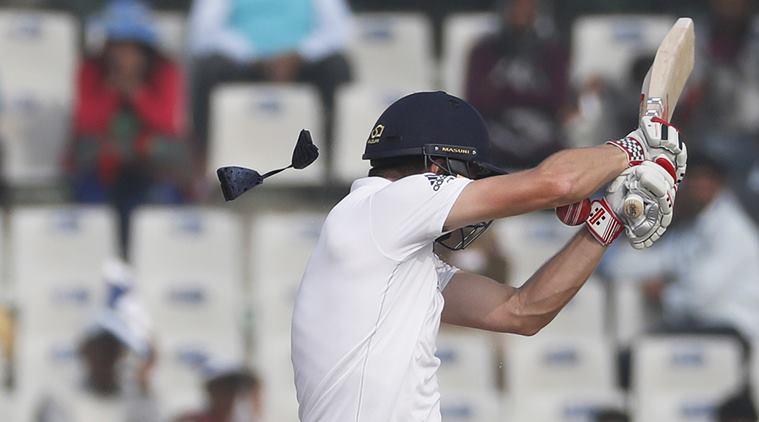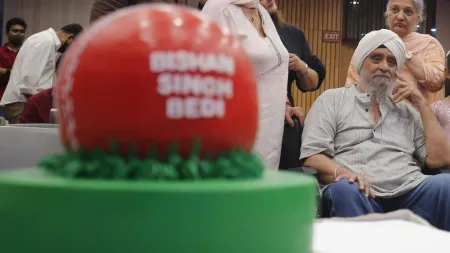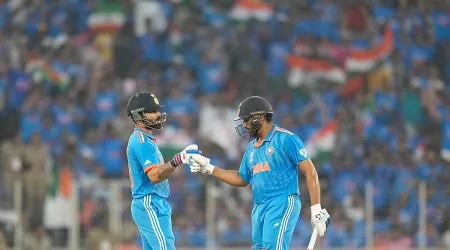- India
- International
Indian pacers make England batsmen jump in Mohali
With the second new ball, Umesh Yadav and Mohammed Shami revoked memories of Ishant Sharma in Lord’s, relentlessly trampolining the balls.
 Chris Woakes has his neck protector dislodged from the helmet after fast bowler Mohammed Shami’s bouncer caught him flush on the ear guard. (Source: AP)
Chris Woakes has his neck protector dislodged from the helmet after fast bowler Mohammed Shami’s bouncer caught him flush on the ear guard. (Source: AP)
A piece of Chris Woakes’s neck protector flew and dropped tattered on the crease. The bowler Mohammed Shami and a few other Indian fielders looked alarmed. The old timers among the sparse crowd must have suddenly transposed in time to the inaugural Test here, when one of Courtney Walsh’s signature perfume balls disfigured the bridge of Manoj Prabhakar’s nose. The worry was amiss, for Woakes was not bleeding and was still on his feet.
Generally, bowlers tend to restrain their aggression when the batsman is pinged on their helmet. But not Shami. The follow-up was an even meaner bouncer, straighter and more direct. It nipped a steadily branching partnership between Haseeb Hameed and Woakes.
Before we begin to detail how the bouncer and short-pitched bowling suddenly came into vogue in the remainder of the contest, a digression about the strained chemistry between Indian seamers and bouncers. Indians, always, were reluctant purveyors of it. The first time an Indian bowler brought out a really effective bouncer was when Kapil Dev — it has to be him isn’t it? —screamed one past a helmet-less Sadiq Mohammed on a bland strip in Faisalabad in 1978. According to opener Sunil Gavaskar, it denoted a coming-of-age moment for Indian cricket.
He wrote: “The normally unflappable and quiet Syed Kirmani clapped with his gloves and screamed ‘Shabhash! Aur ek! (one more)’. To those of us in the Indian batting line-up who had only got used to facing a bombardment of short-pitched deliveries, with only a pea-shooter to return the fire, the sight of an opposing batsman asking for a protective helmet and then getting hit on it, was not only one for sore eyes, but also for cracked fingers and the badly bruised chests and thighs, that we had suffered over the years.”
There is historical context to it as well. Such was the lure of non-violence that Mohammad Nissar, who CK Nayudu rated as faster than Harold Larwood in his early spells, refused his captain Wasir Ali’s order to bounce at Vinoo Mankad in the Pentangular tournament in 1939. In the 70s, Karsan Ghavri emerged as the first bumper -happy Indian who famously peppered Jeff Thomson with bumpers at the urging of captain Bishen Singh.
But strangely enough, Kapil’s successors weren’t the finest exponents of the short ball. They trusted the more conventional means of swing and seam, and belatedly pace. Not that they tried less — in Australia they over-did it only to see the batsmen pulling and hooking with disdain — but couldn’t nuance it. Instances of Indian bowlers out-bouncing were far too few.
Bouncer burst

The present crop of bowlers, though, think differently. At least Shami and Umesh Yadav do. So with the second new ball, they revoked memories of Ishant in Lord’s, relentlessly trampolining the balls. Two of the last three England wickets fell that way. The onslaught came unwarned, for banging the ball of a lifeless strip seemed an exercise in futility. The bouncer burst was just one of the several instances of Shami and Yadav opting for alternative ways when usual tactics didn’t work.
When conventional swing wasn’t forthcoming, they strove moving the ball off the seam. When reverse swing was hard-found, they’d bring in the cutters and slower ones into play. Or in Shami’s case, he would procure reverse seam. Whereas most bowlers would pitch the ball the furthest to extract late swing into the batsman, Shami would land them on good length and break it back devilishly into the batsman. It’s a skill he himself can’t explain. “Jo hota hai wo hota hai,” was his innocent answer when asked to explain the phenomenon on his Test debut, when he left the West Indies batsmen dazed. But the unrelenting accuracy it though is practised.
Speaking of accuracy, it was a word missing from Yadav’s lexicon. In the past he would bowl with plenty of heart and pace, but without direction. And whenever he laboured for precision, his pace lagged. But Yadav seems to have finally found the perfect mix, which his numbers in this series would readily approve of. His economy rate has been a stunningly low 3.23. He was thriftier against New Zealand (2.69), suggesting he has turned a new page in his career.
Numbers partially justify Shami—a haul of 10 wickets at 25.50 denotes a bargain buy for an India seamer in India. But he was grossly unlucky in the entire series as several catches were dropped off his bowling.
If indiscipline was Yadav’s bane, it was a splintering body that was Shami’s curse. But after his injury in Australia last year, he has returned fitter and stronger. The results are there to see. The biggest compliment to India’s pace pair is that they have outdone English seamers. Even though they were without Stuart Broad, they seemed a better attack on paper, what with Jimmy Anderson, Ben Stokes and Chris Woakes. And an even bigger compliment was Cook concurring it.
Get latest updates on IPL 2024 from IPL Points Table to Teams, Schedule, Most Runs and Most Wickets along with live score updates for all matches. Also get Sports news and more cricket updates.











































